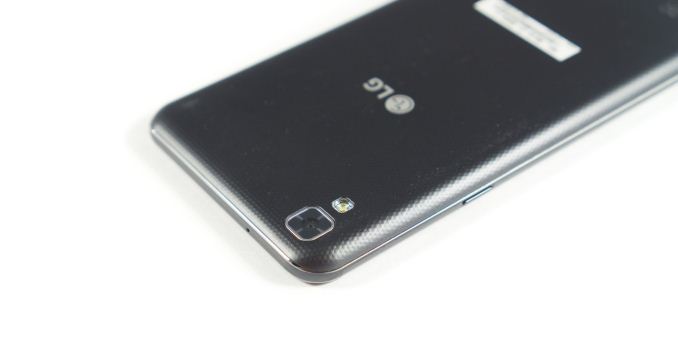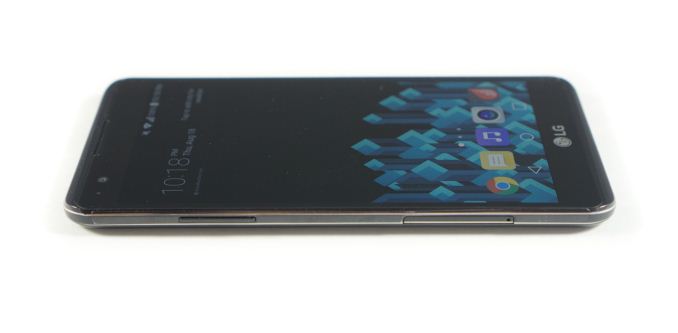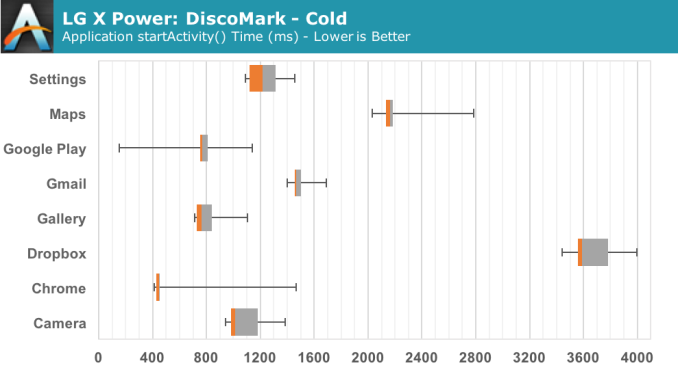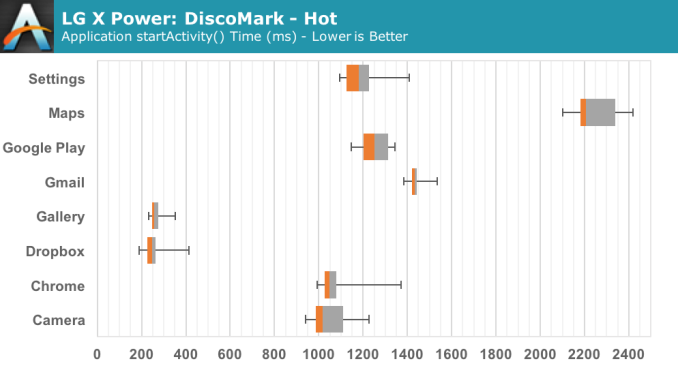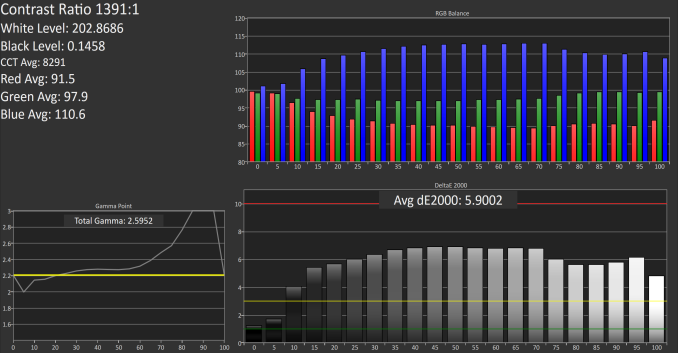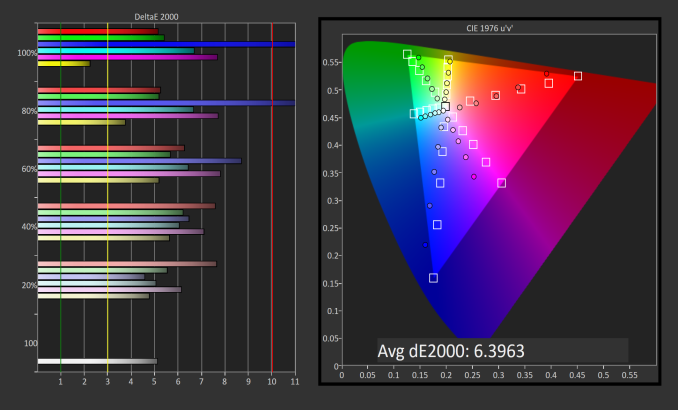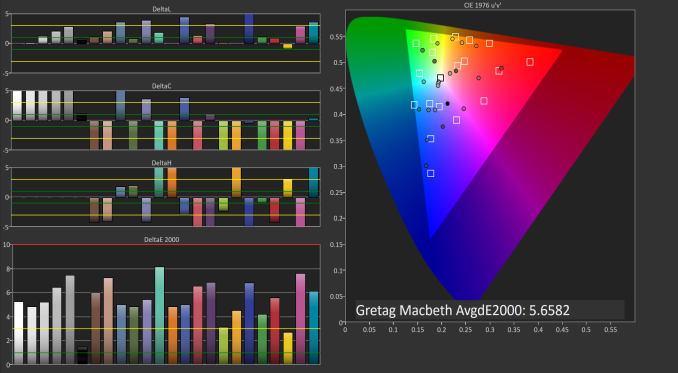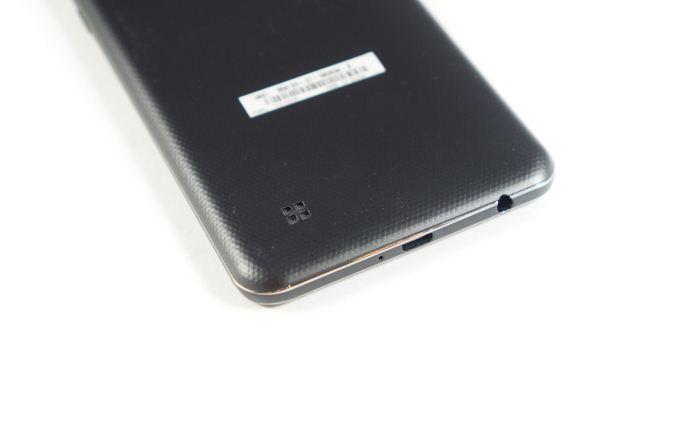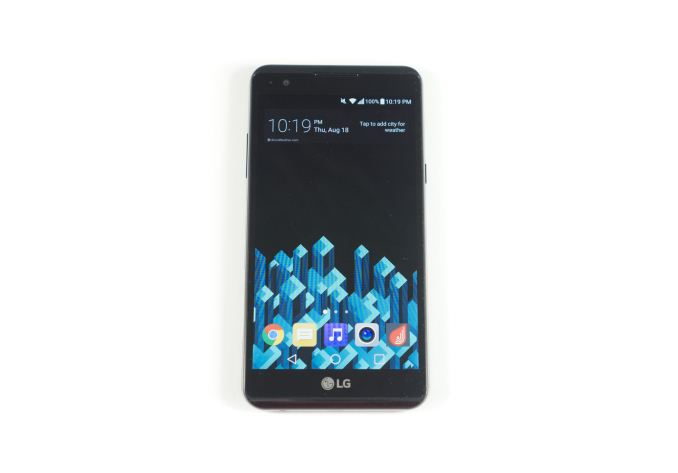
In the mid-range segment of the smartphone market you really have two types of products. The first are smartphones like the Moto G, which try to provide a good all-around experience. They aren’t really exceptional in any respect, but the hope is that providing a decent experience in every respect will lead to a good overall user experience. The second type of device is one that really sells itself on a single feature. Whether it be a great camera, or a great display, the phone’s identity is based on this one aspect. That doesn’t necessarily mean that the other aspects of the phone are bad, but there may not be the same balance as there is with a good all-around performer.
The smartphone I’m reviewing today falls into that second camp. It’s the LG X Power, a device that really sells itself on being a smartphone that will last far longer than any other. The LG X Power is just one device in LG’s line of smartphones that all focus on being the best at a single thing, with some other devices in the line being named the LG X Style, LG X Mach, LG X Max, and LG X Screen. The LG X Power is the first device I’ve ever reviewed that really ties itself to a single feature, and you can check out its entire spec sheet below.
| LG X Power | |
| SoC | Intl: MediaTek MT6735, 4x 1.3GHz Cortex A53 + Mali-T720 North America: Snapdragon 212, 4x 1.3GHz Cortex A7 + Adreno 304 |
| RAM | Intl: 2GB LPDDR3 North America: 1.5GB LPDDR3 |
| Display | 5.3″ 1280×720 IPS LCD |
| Size / Mass | 148.9 x 74.9 x 7.9mm, 139g |
| Battery | 4100 mAh |
| Rear Camera | Intl: 13MP f/2.2 w/ 1080p video record North America: 8MP f/2.4 w/ 720p video record |
| Front Camera | 5MP f/2.4 |
| Storage | 16GB + MicroSD |
| Connectivity | 2.4GHz 802.11 b/g/n + BT 4.1, Micro-USB 2.0, GPS/GNSS, 3.5mm audio |
| Price | $ 159 USD on Cricket Wireless |
To start things off, the word power in LG X Power definitely isn’t referring to a powerful SoC. The LG X Power comes in two versions, with the international model using MediaTek’s MT6735 SoC and the North American model using Snapdragon 212. These SoCs don’t actually use the same ARM cores which is really strange, and they’re not paired with the same amount of memory either. The unit I’ll be reviewing today is the generally less powerful North American variant, which has four Cortex A7 cores that reach a peak frequency of 1.3GHz, along with 1.5GB of LPDDR3 memory and an Adreno 304 GPU.
The display on the LG X Power is the same size as LG’s flagship G5 smartphone, but with just one quarter of the pixels. It’s a 5.3″ IPS LCD display with a resolution of 1280×720. At this size LG is pushing the boundary of where 720p remains acceptable, but given that the phone’s purpose is to provide great battery life, the choice of a 720p resolution was likely a calculated decision to avoid putting additional strain on the battery.
The LG X Power gets more interesting when you take a look at its battery and the overall size of the phone. It has a large 4100mAh battery, but it packs it into a relatively thin and light chassis. I’ll talk more about that in the design section below, but LG has managed to include a large battery without making the phone too heavy to comfortably use like some other smartphones with large battery capacities are.
The cameras are another point where the LG X Power differs between its two models. Both have a 5MP front-facing camera, but the North American model only uses an 8MP sensor, while the international model is 13MP. The aperture is also wider on the 13MP version, and MediaTek’s ISP allows for 1080p recording which is not available on Snapdragon 212.
As for connectivity, there’s 2.4GHz 802.11n support, Bluetooth 4.1, GNSS, and your standard Micro-USB and 3.5mm audio ports. LG also provides a MicroSD slot for expanding the 16GB of internal memory.
The LG X Power has a very functional design. Given that it sells for around $ 150, you won’t find an aluminum unibody or chamfered edges here. However, smartphones like the Moto E have shown that it’s possible to build a solid feeling smartphone even when working under heavy budget constraints.
For whatever reason, the back of the LG X Power actually reminds me of my original Galaxy S i9000. The pattern on the back cover, rectangular camera lens, and double slit speaker are all very similar, although their placement is not identical. Of course, the feeling of the two phones is completely different. The LG X Power’s back cover has a texture to it that is quite fine, but helps in making it easier to grip. You can’t remove the back cover, which is good because it allows LG to make decisions about the internal layout to increase the space for the battery that would not be possible if the phone had a removable cover and a hard-cased battery. This also prevents the flex that many mid-range smartphones with removable covers have near where the cover meets the edges of the phone.
The edge of the phone actually reminds me of my Galaxy S as well, which isn’t really a good thing. The fake chrome finish looks really tacky, and LG would have been better off just making it black plastic with a matte finish or something of that sort.
Even though the LG X Power has a 5.3″ display, the usability in one hand isn’t too terrible. It’s definitely not as good as something like the iPhone 6s or the Galaxy S6, but it’s not as difficult as the 5.5″ and 5.7″ devices that are coming into the mid-range like the Moto G4 series. LG has opted to put the volume rocker on the left side of the phone, and the sleep/wake button on the right. This is the same decision they made when bringing the LG G5 back to 5.3″ from 5.5″ with the G3 and G4, which used rear-mounted buttons. As someone who has used a lot of Samsung and Apple devices, I don’t mind this at all, but I know that some users find it bothersome to have the volume rocker on the left side of such a large device.
The front of the phone is fairly basic, as most smartphones are these days. There’s an earpiece on top, and a large LG logo on the bottom just in case you forget which phone you’re using. I think it would have been helpful to put some capacitive keys there instead, although in the case of the LG X Power this can actually be excused as a method of freeing up additional internal space to fit a larger battery.
When I first got the phone, I was really surprised that LG was able to fit such a large battery into a device of this size. Readers may be wondering why other vendors can’t fit such large batteries into phones that are actually larger and heavier. Unfortunately, I can’t rip apart the LG X Power to show the insides, but based on how the insides of other phones look it’s possible to make some educated guesses. Given the simple specifications of the LG X Power, one can guess that the layout of the logic board isn’t very complicated. As I mentioned earlier, not having the removable back gives LG some freedom to arrange things internally to maximize the amount of space for the battery, and not having any electronics under the bottom bezel for capacitive keys helps with that as well. In a phone with additional coprocessors, larger camera sensors, and other objects on the logic board, it’s more difficult to fit a large battery.
With smartphone design you’re always balancing a series of tradeoffs. The design of the LG X Power is fairly plain, and it doesn’t bring on the excitement that a phone like the Honor 5X does by putting a metal chassis in a relatively inexpensive phone. In LG’s case the phone really has to sell itself on the large battery because the other aspects of the phone aren’t too exciting, but there’s definitely a market for that sort of smartphone if LG can provide a decent experience for the other aspects too. Ultimately the LG X Power’s design is functional rather than beautiful, and that’s really what the phone is about.
The name LG X Power can be interpreted in two ways. You might think that it means the phone is very powerful, or you might think that it has a massive battery. Of course, it could be both, but the phone would probably cost a bit more than $ 130 if that were the case. In the case of the LG X Power the name does refer to its battery, which comes in at a massive 15.58Wh. This is much larger than many phones that are actually thicker, larger, and heavier than the LG X Power, and I discussed in the previous section the likely reasons why LG was able to fit such a large battery into the phone.
It won’t be surprising if the LG X Power outlasts every other device that I compare it to, but I did want to preface the review with our battery life tests instead of performance tests. I believe that the LG X Power’s appeal will be to users who need an exceptionally long period of usage on a single charge, but it’s not immediately clear based on the battery capacity alone how much longer the LG X Power can last than competing devices. The battery life advantage will have to be balanced against any potential disadvantages that the LG X Power provides, and so it makes the most sense to start off with the battery results before examining other aspects like performance, display, and camera quality.
As always, I’ll begin with our internal web browsing battery test, followed by PCMark’s battery test. Normally I would also include our GFXBench Manhattan ES 3.1 battery benchmark, but the LG X Power’s GPU and drivers do not support OpenGL ES 3.1 which prevented me from running it.

In our WiFi web browsing battery test the LG X Power comes in at the top of the chart. At 12.77 hours it lasts much longer than most mid-range devices like the Moto G4 and the iPhone SE. When compared to devices of similar battery capacity like the Xiaomi Redmi Note 3 and the Meizu M3 note you can see that it only lasts a bit longer. This is important to note because while the LG X Power is a smaller and lighter device than either of those, it’s not a great deal smaller, and it doesn’t compare very favorably as far as specifications are concerned either.
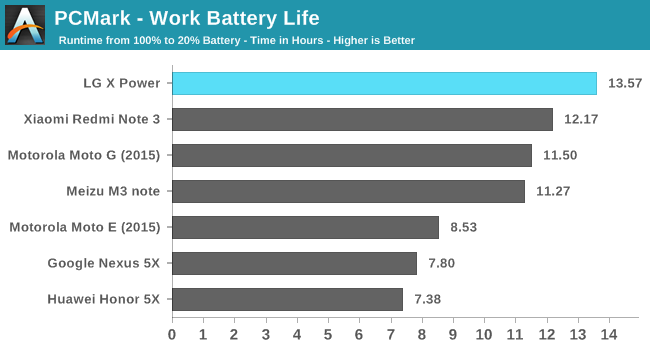
In PCMark’s battery test the LG X Power continues its lead over the other smartphones. In this case the gap between it and the competition from Xiaomi and Meizu is much more significant, and PCMark is a good representation of the usage that a device can provide on a single battery charge, so this is arguably a more important test for the LG X Power to excel in than the web browsing test. In the following section it will also be important to make note of how the LG X Power performs in PCMark compared to those phones.
As expected, the LG X Power does well in our battery benchmarks. It would be hard to do anything else when you pair a 15.58Wh battery with fairly humble hardware, but we’ve seen stranger things happen with mobile devices. I don’t really have much else to say here except that the phone definitely lives up to its name.
Charge Time
Smartphone charge time has been an issue in the past for mid-range smartphones. In some cases I’ve received chargers that aren’t even your standard 5W blocks, and some were only half that at 2.5W. Thankfully we’ve seemingly moved past that time, and even though the LG X Power packs such a large battery one would hope that the time to charge it isn’t extensive.
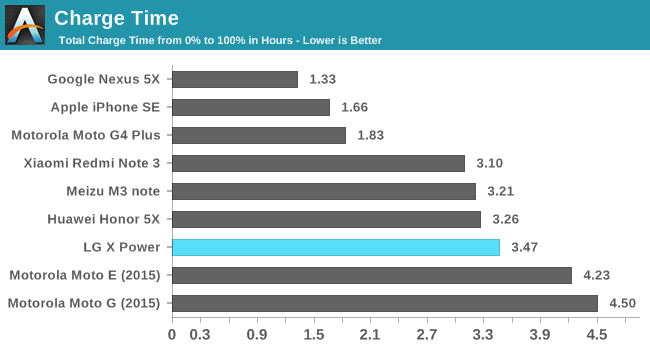
With its stock charger, the LG X Power takes about three and a half hours to go from 0 to 100% charge. Considering the size of its battery, this isn’t a bad result, although the Meizu M3 note and Xiaomi Redmi Note 3 both charge a bit quicker. Given the fact that LG’s charge time is similar to the Honor 5X which has a 25% smaller battery capacity there’s not really anything to complain about.
As I mentioned on the first page, the LG X Power comes in two versions. The international model uses MediaTek’s MT6735 SoC, which has four Cortex A53 cores with a peak frequency of 1.3GHz. The North American model uses Qualcomm’s Snapdragon 212 SoC with four Cortex A7 cores that also reach a peak frequency of 1.3GHz. Depending on the workload, there can be a considerable performance difference between Cortex A7 and Cortex A53. I don’t know why LG has opted to ship two models of the same phone with significantly different SoCs, and it would have made much more sense to use Snapdragon 410 in the North American market.
I don’t have both models of the LG X Power available for review, so I can really only speak to the performance of the North American model. There will definitely be differences in CPU and GPU performance between the two, and it’s also important to note that the international model has an additional 512MB of RAM. Since the LG X Power doesn’t support OpenGL ES 3.1, I’ve cut some of the benchmarks from the standard group that I run. Below I’ve organized the remaining benchmarks into sections that represent what part of the system each benchmark tests.
App Performance

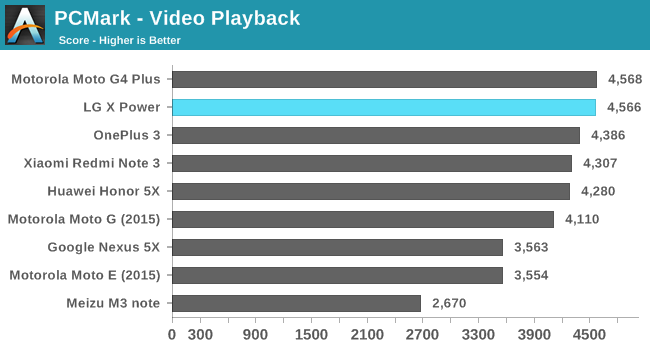

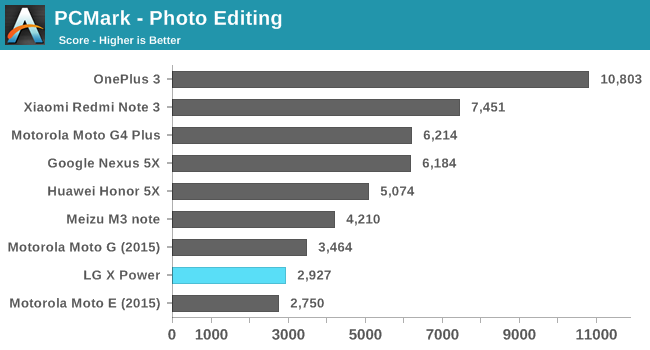
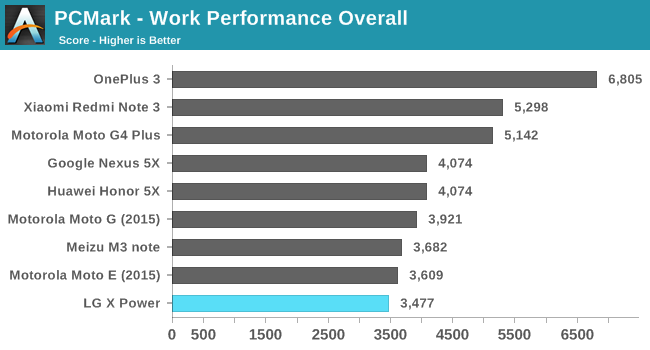
PCMark is a good benchmark because it simulates actions that users perform on a daily basis, and does so using the same system APIs as real applications. This makes it particularly sensitive to software optimizations, as well as changes in Android version that bring improvements to the Android API.
The LG X Power doesn’t get off to a good start in PCMark. In every sub-test except the video playback test it is one of the slowest devices on record. While it doesn’t come in very last in photo editing or writing, it’s close enough that the devices it beats in those individual tests actually end up doing better when all the scores are aggregated, making the LG X Power the overall slowest device on record for PCMark.
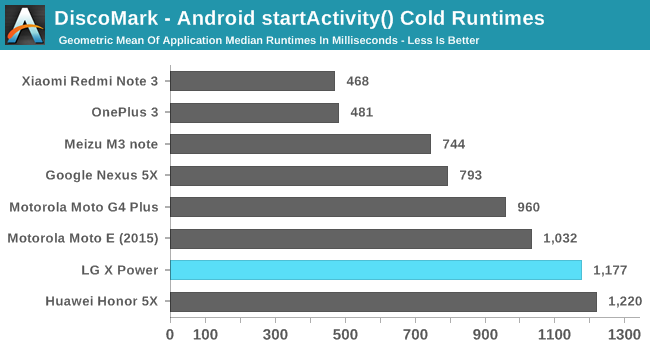
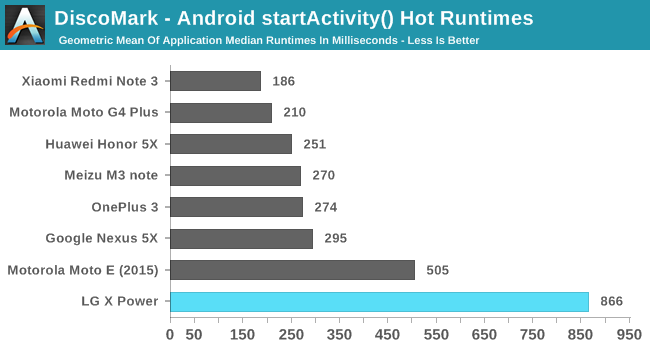
DiscoMark is a new addition to our benchmark suite. It allows us to measure the time it takes for an application to launch by monitoring how long it takes for an Activity to be created after a call to Android’s startActivity method. For testing we have selected a group of commonly used applications, and the box-and-whisker diagrams allow the quickest and longest launch times for each app to be displayed, along with the first and third quartile boundaries. We also split the test into two parts, with the first being cold launches where an application has been killed before being launched, and hot launches where an application will still be resident in memory if the phone has enough RAM to accommodate it.
Unfortunately, DiscoMark shows how limiting the 1.5GB of RAM in the LG X Power is. In the cold launch test you’re really limited by the speed of your SoC, and to an extent your NAND speed as things are read from persistent storage and loaded into memory. In this case the LG X Power is in line with Cortex A53 devices despite its use of a Cortex A7 CPU, which isn’t a bad situation to be in.
The real issue for the LG X Power is the hot app launch times. The average median runtime for launching an app that could be resident in memory is 866ms, nearly twice as long as the next slowest phone, and three or four times slower than most other smartphones. It’s apparent that LG is having to evict applications quite frequently, which means that although we aren’t forcibly killing the apps, they’re being re-created from scratch nonetheless. One interesting thing to note is that the Moto E (2015) performs much better despite having only 1GB of RAM, and this is probably a combination of LG’s much heavier software customizations, along with different policies for memory management, data caching, and app eviction.
The impact that this has on the user experience is immense. It takes nearly a whole second to switch to an app that you would expect is still in memory, because it has often been evicted if you’ve opened only a couple other apps since you last used it. It makes the phone feel incredibly painful to use, to the point where you end up not using the phone because of how slow it is. With that in mind, the phone’s large battery looks more like an insurance policy than a useful feature, because the phone will already last a long time by virtue of you choosing to avoid using it unless you absolutely need to.
Web Performance



Unsurprisingly, the LG X Power is the slowest device in all three web benchmarks. A quad core Cortex A7 SoC is just not competitive at all, even against the Moto E from February 2015, which launched at a lower price than the LG X Power. I don’t really have much else to say here, as the web browsing performance of the LG X Power is just terrible, and I find it shocking how LG has seemingly bet the entire phone on a giant battery and neglected performance entirely, to the detriment of the user experience.
Graphics Performance

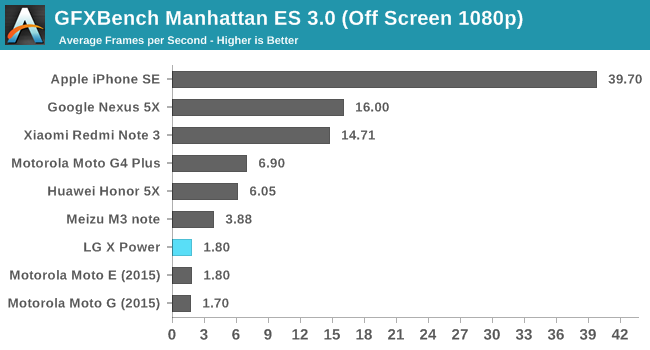
Adreno 304, 305, and 306 are essentially identical, so it’s not a surprise to see that the LG X Power sits right beside devices that use Snapdragon 400 and 410 in GFXBench’s Manhattan ES 3.0 graphics test. Low end smartphones just don’t have great GPU performance, although it won’t prevent simple 2D games from being played. I don’t expect this to change any time soon for phones that cost close to $ 100, but I also doubt that it impacts the kind of user that purchases a $ 100 phone in any appreciable manner.
NAND Performance
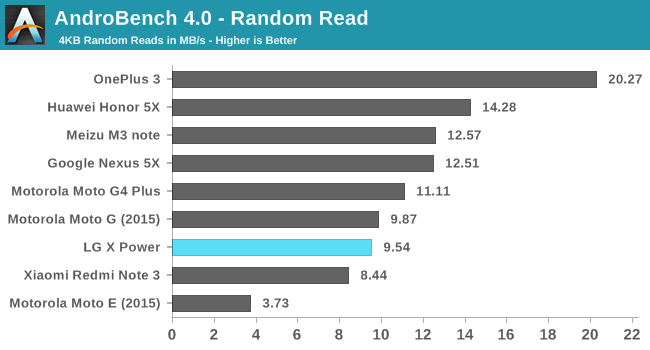


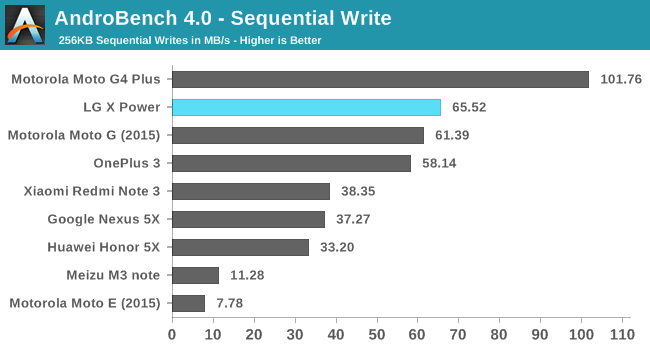
NAND performance on the LG X Power is actually decent as far as low-end smartphones go. Random read and write performance is definitely low, but sequential read and write performance is actually pretty good among the low-end and mid-range phones in the comparison. I don’t expect that mid-range smartphones will move away from eMMC storage any time soon, so this is around the best storage performance that you’ll see in a $ 100-150 smartphone.
Different people value different aspects of a smartphone more than others, but I think everyone can agree that it’s important for a smartphone to have a nice display. A smartphone’s display is the portal through which the user can interact with the interface, and if that display is dim or has poor color characteristics that will have a persistent and negative impact on the user experience.
Many users have differing preferences as far as display color is concerned. We can all agree that a display should be sharp, bright, and have good black levels, but with color different users may like different things. To avoid that sort of subjectivity, we target the sRGB color gamut which is the standard used for essentially all digital content, including both content on the web and video content provided via streaming and existing home media. To analyze a display’s quality relative to the sRGB standard, we use X-Rite’s i1Pro 2 spectrophotometer for measurements, and SpectraCal’s CalMAN 5 software for collecting data.
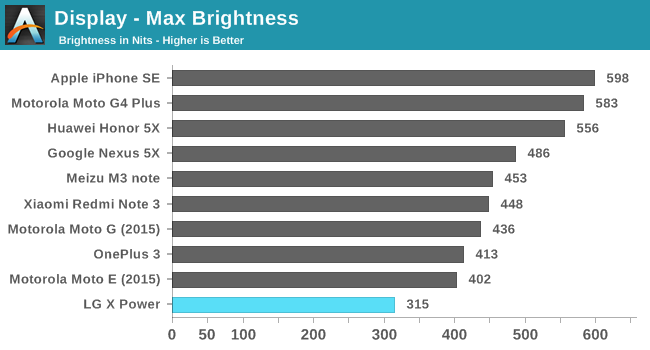
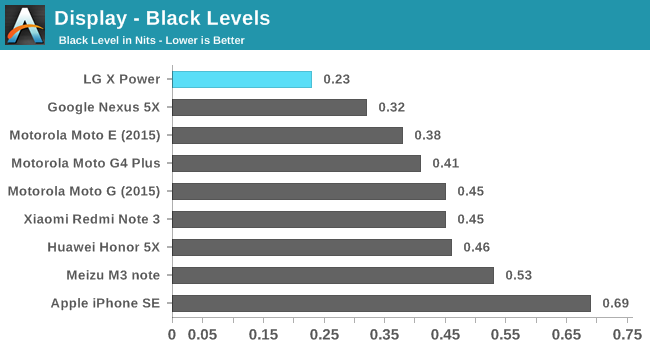
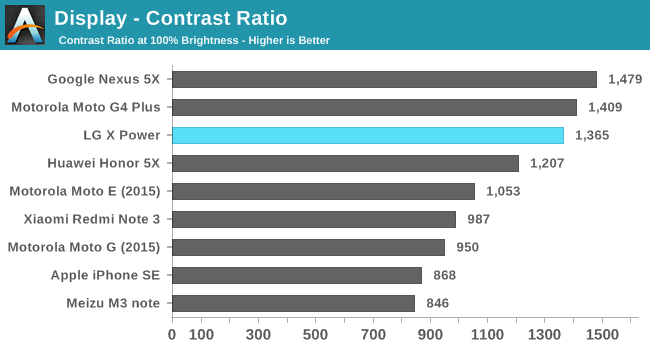
The LG X Power appears to do well with its black levels, but that has to be evaluated in the context of the peak brightness, which is incredibly low. I haven’t come across a device that can’t break 400 nits in quite some time, and at this point if you’re coming in well below 425-450 nits you’re not up to par with the competition. On top of the low brightness, the LG X Power’s glass is pretty reflective, and the combination of those two factors make it essentially unusable outside.
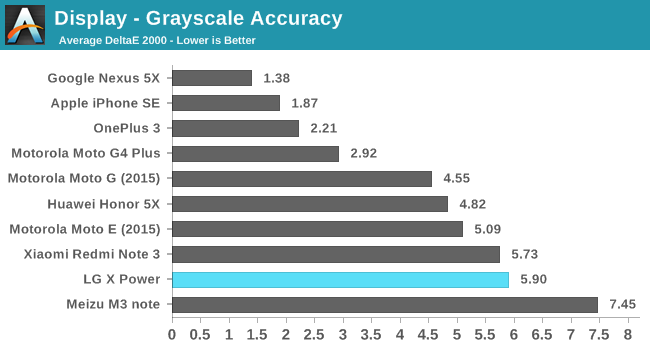
Greyscale accuracy on the LG X Power is very poor. The first thing that stands out is the gamma curve. LG is ramping up gamma as you move past 50% white in order to alter the steps between each level. This can make the display look a bit punchier as one might say, with the saturation of colors increasing more quickly past that point. Displays often do this to avoid looking very dull when they can’t cover the sRGB gamut, and I’ll talk more about that in a moment.
Going back to the greyscale, the second issue is just how far the display shifts toward blue. All shades in the greyscale beyond pure black have a noticeable blue tint, and from 20% grey onwards the unbalance of red and blue components is quite severe. As far as the average person’s definition of grey goes, it wouldn’t really be wrong to say that the LG X Power isn’t actually capable of showing that color. When I consider the low peak luminance, I can’t help but wonder if this is all part of LG compensating for poor display efficiency by clamping brightness and setting the display to a blue-shifted white where the LED backlights will be more efficient. Whatever the case may be, the end result is a very blue looking display that isn’t visually appealing at all.
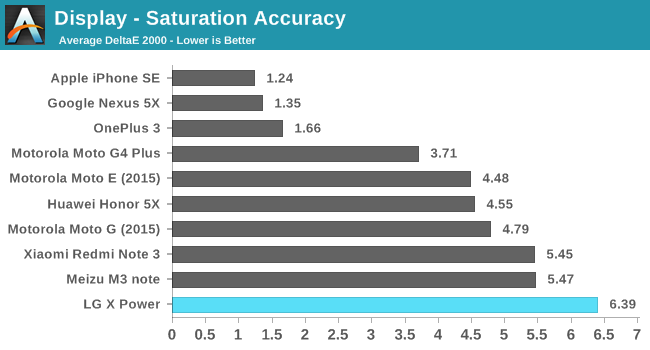
Recently there was a bit of controversy over my review of the OnePlus 3 where I criticized its target gamut as being irrelevant and wider than sRGB without any color management. It sparked a debate about user preferences, and whether users actually preferred displays that show oversaturated colors. Whether you prefer oversaturation or accuracy, I think everyone can agree that sRGB isn’t exactly the widest gamut, and that nobody is going to like a display that is actually less saturated than sRGB.
The saturation sweep test exposes the true problem with the LG X Power’s display, which is that it falls into that category of undersaturated displays that nobody really likes. It’s a narrow gamut display, and it cannot accurately reproduce any colors because the range of colors has been compressed into an area much smaller than the sRGB gamut. What should be 100% red is a lot closer to where 80% should be, and 80% is where 60% should be, and so on. This is true for any colors that depend on red or blue, which is to say, every color that isn’t green. Green isn’t doing so well either because the hue is thrown off by the display’s shift toward blue.
In the end. the average DeltaE for primary and secondary saturations is about 6.4, which is a very significant error. The undersaturation makes the display appear so lifeless, with every color being much duller than on other smartphones. You only need to look at Google’s app icons to see that the red, green, blue, and yellow are just not as lively as you’re used to seeing. LG tries to combat this by ramping up the gamma as you move past 50% saturation, but there’s no escaping the fact that the LG X Power cannot display a great number of colors that every other phone can.
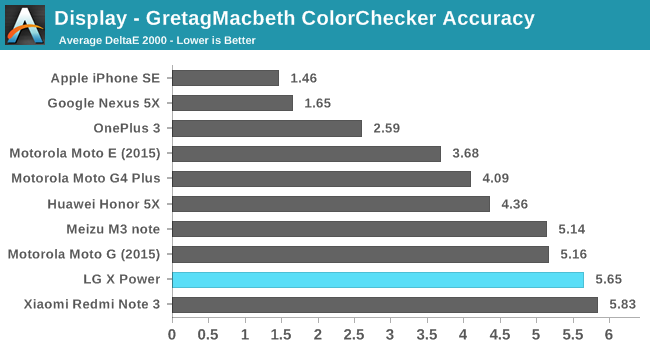
The issues with both the greyscale and saturation tests leave little chance of performing well in the GretagMacbeth ColorChecker test. The average error is 5.66, with both shades of grey and color mixtures exhibiting high levels of inaccuracy. Luminance is generally not the issue here; issues with chroma and hue are the main source of error, which makes sense when one considers the blue shifting in the greyscale and the narrow gamut.
I’m really disappointed by the LG X Power’s display. I have no idea who at LG decided that it was acceptable to ship a narrow gamut display in a smartphone, but they were sorely mistaken. This display should never have been put in a 2016 smartphone, even a relatively inexpensive smartphone like the LG X Power which costs about $ 130. You’ve been able to get full sRGB coverage, 400+ nits of brightness, and a decent level of accuracy on $ 100 smartphones for nearly two years, so there’s absolutely no excuse for LG shipping such a dim and dull display on the LG X Power.
The camera is another aspect of the LG X Power that differs between the international and North American models. The international model sports a 13MP camera with a f/2.2 aperture and 1.12µm pixels, while the North American model drops down to an 8MP sensor with an f/2.4 aperture. The North American model also gives up 1080p video support and can only record at 720p, which is honestly sad for a smartphone launching in late 2016. The reason for this is simply a limitation of the SoC’s image signal processor, and so it’s just another situation where the North American model is crippled as a result of its SoC.
I’m really not a fan of LG selling two different phones under the exact same name just because they look the same, but I can really only work with what I have. I’ve done two photo comparisons with the LG X Power just to get an idea of what one can expect from the 8MP rear-facing camera on the North American model.
I actually haven’t reviewed many phones in the $ 100-150 price bracket lately, so it’s difficult to find direct comparisons to the LG X Power as far as camera quality goes. The 2015 Moto G is now available for around $ 150, so it’s a decent point of comparison even if it has been replaced by a newer but not really better model. In this situation, the LG X Power’s image quality leaves much to be desired. The overall sharpness isn’t really any better than the 5MP Moto E from early 2015, and it’s not near as good as the 2015 Moto G with its 13MP IMX 214 sensor from Sony. LG is likely running into ISP limitations as well, but that’s what happens when you put an SoC for $ 50 phones in a $ 150 phone.
Low light photos on the LG X Power actually aren’t that bad considering the phone’s price. In this scene it’s able to hit focus, which is something other phones actually struggle with. There’s clearly chroma noise throughout the frame, but detail isn’t being washed away by heavy noise reduction like it is in the Moto G4’s photo. I think the quality and overall exposure is actually very similar to that of the 2015 Moto G despite the difference in resolution between the two. As far as low-end smartphones go, the LG X Power actually isn’t half bad shooting in the dark, although it’s not going to be at the level of a $ 250 smartphone like the Moto G4 Plus.
LG’s strategy with their low-end and mid-range smartphones has been to segment them into products that all focus on a single feature. You have the LG X Style, the LG X Screen, the LG X Mach, the LG X Max, and of course, the LG X Power. I suppose that the thinking behind this strategy is that consumers tend to value one thing in a smartphone more than all the others, and by providing different models that focus on one thing you can hopefully attract the attention of the consumers who care most about that feature.
Unfortunately, I think LG’s strategy has really missed the mark. Consumers definitely do value some things more than others in smartphones, but just by looking at LG’s smartphones you can see that they sacrifice the quality of other aspects to focus on a single feature. No consumer wants a phone that only does one thing well, they just have priorities about what a phone should do best. In that situation, a phone that tries to provide a good all-around experience is going to win every time, because a smartphone that only does one thing well and fails at everything else is just going to frustrate the user and drive them away from the device.
The LG X Power does live up to its name if you interpret its name as meaning it has a large battery. In our WiFi web test and PCMark’s battery test it topped the charts. However, the victory wasn’t always by a large margin. Xiaomi’s Redmi Note 3 was very close, and it’s a phone that does many things well, which contrasts with the LG X Power that really only focuses on providing long battery life. To me this really signifies the failure of LG’s strategy. You can build a good all-around smartphone that isn’t really much worse than the LG X Power as far as battery life goes, and better in every other respect.
When you set aside battery life, the LG X Power is mediocre at best, and often a lot worse. The camera isn’t very good in daylight, although it’s better than I expected when shooting in the dark. The display is not pleasing to look at, with a low brightness, dull colors, and a ghastly blue cast. I don’t know why the display was even produced, but it never should have shipped on a modern smartphone.
As for performance, it’s just completely unacceptable on the North American model. The UI is janky and slow, and the process of opening apps is painful because there’s not enough RAM to keep even a modest group of apps resident in memory. It’s the only device I’ve seen where the DiscoMark launch times were barely any faster when launching apps that could and should have been in RAM. General performance within apps is no better, with the jankiness remaining and the SoC being too slow to keep up with tasks like web browsing and general UI navigation. These issues may not be as pronounced on the international model, but the fact that LG is shipping two vastly different models is a huge problem in its own right.
I mentioned this once before, but I don’t think the LG X Power even needs its large battery to provide long battery life. The phone’s experience is bad enough that users will want to avoid using it, and by virtue of that it will last a long time by being constantly idle in a pocket or a drawer. In that sense, the phone is really a failure at its one key task, because the phone has a giant battery but nothing worth powering.
I never mean to be overly negative in reviews, but in the case of the LG X Power it’s really just a case of there being very few positive things to point out. It’s a phone that can last a long time, but the user experience is poor and the phone is so slow that you’ll never want to use it. The display is basically not usable outdoors, and it has a lifeless feeling to it that I didn’t think I’d see on a smartphone again. There are just so many better options than the LG X Power, and some of them like the 2015 Moto G are a year old by this point. You simply cannot make a good smartphone by focusing on a single feature, because good smartphones care about every feature.
Autore: AnandTech


